Also called an Indoor Rower or Ergometer, it simulates the act of water-sport rowing. Rowing is an exceptional cardiovascular exercise and engages multiple muscle groups to provide a full-body strength and endurance movement.
Key components of the rowing machine:
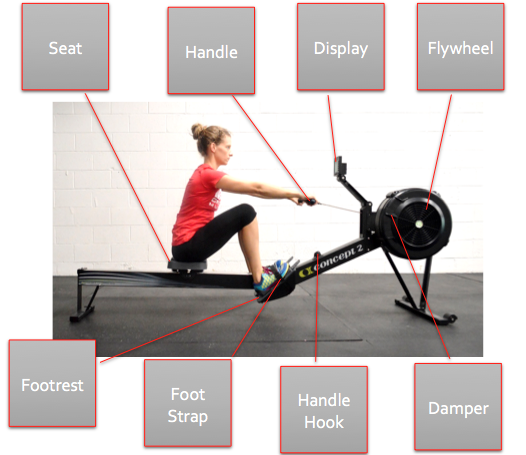
Set-up:
- Sit centered on the seat. Place feet under the foot straps on the foot rest. The top of your shoe should come about ½ inch over the foot ramp. The foot rests are adjustable and numbered to make setting up your feet simple each time you row. Pull the foot straps tight.
- Turn on the display and set it to the desired data measurement (meters, calories or watts) and view.
- Set the damper to desired number – typically 3-5 for beginners. Higher damper settings allow more air into the flywheel housing. The more air, the more work it takes to spin the flywheel against the air. More air also slows the flywheel down faster on the recovery, requiring more work to accelerate it on the next stroke. Lower damper settings allow less air into the flywheel housing, making it easier to spin the flywheel.
- Pull the handle out of the handle hook and set your grip. Hands should be even on each side. Extend your arms straight toward the flywheel, and keep your wrists flat.
- Spine should be neutral and tilted forward slightly at the hips. Shins vertical and feet firmly planted in the foot rests.
Performing the Row:
Catch

- Extend your arms straight toward the flywheel and keep your wrists flat.
- Slide forward on the seat until your shins are vertical.
- Lean forward slightly at the hips.
- You are ready to take the first/next stroke.
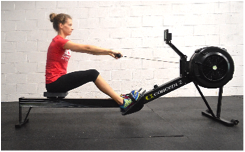 Drive
Drive
- Begin the drive by extending your legs and pushing off against the foot pads.
- Keep your core tight, arms straight and back firm as you transfer power to the handles.
- As your knees straighten, gradually bend your arms and lean your upper body back.
Finish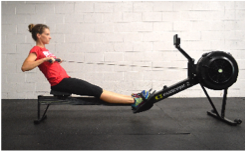
- Bend your elbows and pull the handle into your sternum.
- Extend your legs.
- Lean back slightly at the hips.
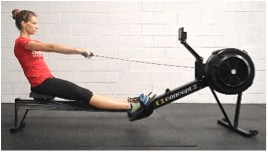
Recovery
- Extend your arms by straightening your elbows and returning the handle toward the flywheel.
- Lean your upper body forward at the hips to follow the arms.
- Gradually bend your knees and slide forward on the seat to the start (or catch) position.
Focus on consistent steady movement – You are the master of the numbers on the display, not the victim of them. Steady consistent movement will be more efficient. Remember you are on the “water” – smooth movement is rewarded. Smooth movement is fast and efficient. Jerky movements make waves and flip boats.
Common Rowing Mistakes
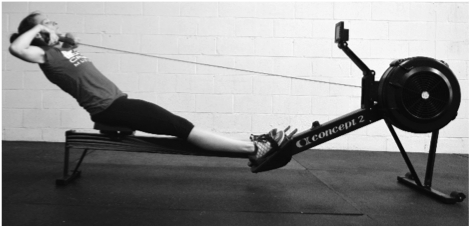 Finish handle position too high or low
Finish handle position too high or lowPulling the handle too high or low doesn’t allow for optimum muscle engagement therefore losing efficiency and power in the pull.
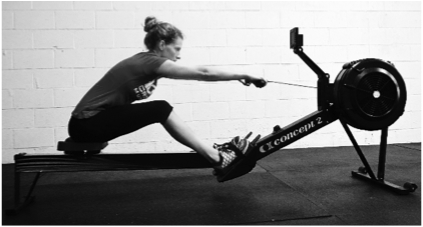
Shooting the hips
If your legs are pushing quickly and causing your rear to shoot out ahead of the rest of you, your upper body will have to awkwardly catch up. Doing extra work to jerk your top half around will make your stroke less efficient, and can cause injury.

Hunching over during the drive
You want to sit tall with a stacked posture. Focus on “turning on” your abdominal muscles, or engaging your core, and relaxing your shoulders so they are pulled back and down. Your spine should always be in neutral.
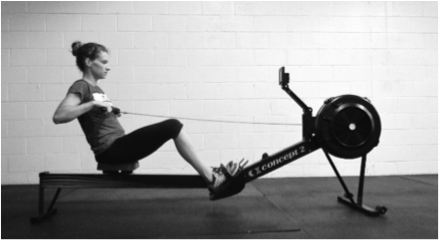
Wrong arm/leg sequence in Recovery
Legs, hips, arms, arms, hips, legs. This is the sequence to remember when rowing. Getting out of sequence makes you lose momentum and power.
